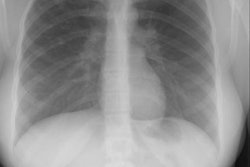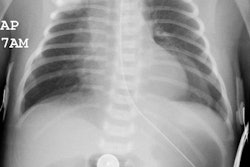Interstitial Emphysema:
View cases of interstitial emphysema
Clinical:
Interstitial emphysea occurs as a result of rupture of overdistended alveoli with dissection of air into the bronchovascular bundles and interlobular septa. The condition can lead to pneumothorax, pneumomediastinum, or pneumopericardium. Interstitial emphysema can be classified into three forms: acute, persistent localized, or persistent diffuse.Acute interstitial emphysema most commonly develops in association with hyline membrane disease or other neonatal pulmonary conditions which require high ventilatory pressures. The condition can also occur in adults on mechanical ventilation.
Localized persistent interstitial emphysea develops in infants with hyline membrane disease, but can also occur spontaneously with no apparent lung disease or assisted ventilation. Treatment is initially non-surgical (decubitus positioning or selective intubation). Surgery is required in some cases due to unmanageable respiratory failure.
Diffuse persistent interstitial emphysema is most commonly associated with bronchopulmonary dysplasia.
X-ray:
Acute interstitial emphysema: On chest radiograph, linear and round bubble-like radiolucencies can be seen. The finding can be focal, diffuse, or bilateral. The involved areas are non-compliant and show static lung volume on expiratory images. On CT, air can be identified within the interlobular septa and around the pulmonary veins.Localized persistent interstitial emphysema: On CXR the condition has an expansile multicystic appearance- with cysts measuring up to 3 cm. These cystic air spaces are localized to one or more lobes and associated with medistinal shift and mass effect.
Diffuse persistent interstitial emphysema:
REFERENCES:
(1) AJR 1997; CT of pulmonary interstitial emphysema. 169: 1381-1384
(2) AJR 1999; Kemper AC, et al. Pulmonary interstitial emphysema: CT findings. 172: 1642
(3) AJR 1999; Donnelly LF, et al. Localized radiolucent chest lesions in neonates. Causes and differentiation. 172: 1651-1658




